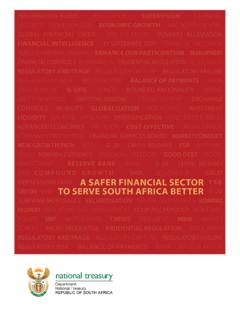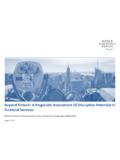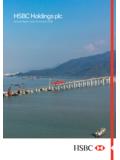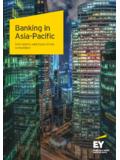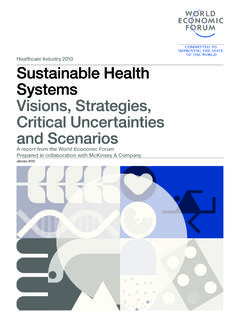Transcription of Creating an agile control environment - 5 insights …
1 5 insights for executives Creating an agile control environment How COOs can balance risk and operational efficiency to promote growth and drive shareholder value Of special interest to Chief operating officer Chief financial officer Chief risk officer The impact of tighter internal controls on a company's bottom line is all too easily overlooked. If there is to be no respite on controls, companies must work far harder with the systems they A global organization that provides gravel and crushed stone to the construction industry was use to ensure compliance. Those who have already taken on operational reforms are reaping the spending four times as much on security to protect its operating sites essentially a pile of benefits.
2 Research shows there is a close correlation between financial performance and the level rocks compared with its more material fraud and risk issues. By reviewing its controls, it managed of integration and coordination across risk, control and compliance Companies in the to increase scrutiny over its sales discounting process and significantly cut costs in other areas. top 20% of risk maturity generated four times the level of EBITDA as those in the bottom 20%. Many other businesses are in the same boat. Despite controls often being inefficient, or misplaced, Working with colleagues such as the CFO and CRO, the COO is well placed to support risk, control they've simply not taken the time to rethink their controls as the business has developed.
3 But as and compliance issues. As the executive with overall responsibility for ensuring that company pressures from rivals, customers and stakeholders mount, there is growing urgency for action. processes offer the best chance of profitable growth, the COO is accountable. At many companies, as much as 30% of process cost relates to controlling activities, yet control environments are often Furthermore, businesses must now accept that the control regimes in which they operate won't failing to support a profitable growth strategy. be shrinking soon. According to a recent report by the World Economic Forum, policy-makers' top concern is the possibility of a major systemic financial 1 Greater regulation is the likely result even though the same report lists regulation's unforeseen negative consequences as one of the top 10 global economic dangers.
4 2 Turning Risk into Results, EY, 2012. 2 | 5: insights for executives What's the issue? Having survived the recession, many companies must now transform their control systems and reshape their businesses for recovery. If they are to thrive, they must find the right balance between too little and too much control . Too little Optimal Too much Unknown leakages in systems Disciplined culture Overspending on controls Poor discipline High degree of control consciousness Bureaucratic culture Erratic performance Enhanced performance Predictable performance A recent EY report3 spells out many of the problems limiting performance Companies are making limited use of continuous monitoring and data analytics and keeping COOs awake at night: when CEOs are demanding actionable insight from big data to guide future Companies are overcontrolled on compliance and financial risks, often at strategies as well as day-to-day operations.
5 The expense of other types of risk management often 40% of controls are Controls are poorly aligned with the risks that matter most and 45% of duplicative or can be removed because they are misaligned with the risks companies have no plan for using a formal risk management methodology deemed most important to the business. when they update their ERP system. One in 5 companies do not leverage automated tools to manage governance, risk These problems are closely linked to underperformance. EY's research shows and compliance, and 4 in 10 say they spend too much time managing IT risks. that top-performing companies have, on average, implemented twice as many key risk capabilities across teams (process, method and infrastructure) as performance laggards.
6 3 Smart control : Transforming controls to reduce cost, enable growth and keep the business safe, EY, 2013. 5: insights for executives | 3. Why now? In the aftermath of the financial crisis, closer control is the new normal, and not However, there are some common barriers to achieving this: only in the financial sector. Now is the time to recognize that reality and to work Mergers, acquisitions and divestitures have not been fully integrated from a out how to operate more efficiently within it. management reporting and operations perspective. By streamlining the controls bureaucracy, COOs can enable their businesses to Organizations that have existing ERP systems have not fully leveraged them to grow with agility and efficiency.
7 Respond to the new risk landscape. Fundamental organizational changes such as offshoring or shared services have introduced inefficiencies or weaknesses in existing controls. IT systems especially if disparate or decentralized have not been assessed for new business risks or do not reflect appropriate controls when adapting to organizational changes. How does it affect you? Companies that reform their controls can streamline operating processes, reduce costs and enable improved performance. This falls into a COO's core domain. In a holistic controls environment , the COO can increase the speed of process execution, build more agility into the organization and, above all, radically improve overall operational performance.
8 4 | 5: insights for executives What's the fix? The COO has a key role to play in developing a holistic controls strategy that Here are six steps toward meeting these challenges and developing a holistic leverages technology to create a single, streamlined set of controls. strategy: To get there, the company must address inefficiencies and failures that have 1. Define a common vision that aligns control activities with strategic goals and increased over time, such as: create commitment in the business Long lead time to adapt operational processes to changing requirements 2. Understand the current state of the control environment , including gaps and high-cost areas, compared with benchmarks Slow decision-making due to a lack of information 3.
9 Design an integrated controls framework, challenging and justifying every Duplication of internal controls and overcontrolled or undercontrolled areas operational control as it relates to the organization's risk tolerance levels Outdated, inefficient practices 4. Automate wherever possible; eliminate unnecessary manual activities Underutilization of application controls 5. Build greater transparency and accuracy through dynamic dashboards and Inconsistent practices across the enterprise the use of analytics 6. Finally, embed the sustainable operating model, performance monitoring and controls across the enterprise Increased shareholder value Align Reduce with control Balancing value, cost and risk in their strategy spend processes and controls helps companies create a competitive advantage.
10 Controls transformation Improved performance Accelerate Improve An integrated, streamlined and dynamic process accountability control environment provides the agility execution for risk to anticipate and respond to changes. 5: insights for executives | 5. What's the bottom line? By improving your controls environment , your organization can achieve: As regulators' demands for increased accountability continue to rise and calls agile processes that can be executed and adapted quickly from investors and shareholders for improved performance grow louder, now is the time to make your control environment as efficient and effective as possible. A streamlined set of low-cost controls that focus on the risks that matter to COOs who help their businesses make the leap will reap the rewards.










